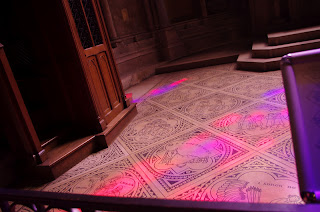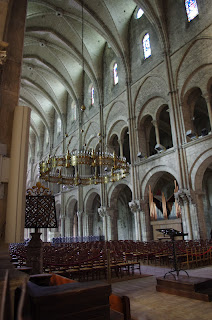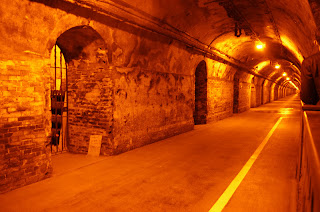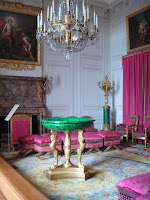After a lovely weekend with Jean-Claude and Corinne and a fun day trip to Reims, it was time for our next foreign travel adventure: Greece. First, let me preface this entry by saying that, despite what you might see on CNN, Greece is a wonderful country. We didn't see any protests or riots (other than some kind of strike in front of a bakery in Thessaloniki!) and life seemed to be going on as normal. The main difference was that where we were in Athens, we saw almost no beggars. Everyone who wanted money was offering some sort of object or service, and many of them were Greek locals, not immigrants. The immigrants who were there selling things were accepted by the locals, and they'd even stop and chat or joke with them, something we have never seen in Italy or France. It was a bit different in Thessaloniki, but we never felt unsafe anywhere we went. Ninety percent of the Greek people we interacted with were extremely friendly, welcoming, and generous. They're very proud of their country and very desirous of showing what they have to be proud of.
 |
Anthony's family's residence. In the
foreground are olive trees, which Lisa
decided to sample. It turns out that
ripe, uncured olives are very bitter! |
Our first experience with Greek (or, really, Greek-American) hospitality came with where we stayed in Athens, the first stop on our trip. We stayed with the parents of my graduate advisor, Anthony. They built a large three-story building for their family; the parents on the first floor, the third floor for Anthony's sister and her family and a floor for Anthony and his family when they come to Greece in the summer. It was very kind of them to let us stay there for a few days. Plus, Anthony's mom provided us with all our breakfast needs and drove us to the metro station every morning so we could get into central Athens and she drove us to the airport our final morning. She also recommended a few restaurants in their neighborhood to try on our first night there (we arrived early evening from France). We chose one on the main square of the town and watched the children play and the adults talk as we ate our food.
 |
| Roman-era marketplace. |
We only had two solid days in Athens and we really packed everything in. Unfortunately, due to Greece's austerity measures, almost all the state-owned museums and archaeological sites close at 3 pm. We didn't know this applied to archaeological sites, meaning we didn't have time our first day to see everything we wanted to see and we had to hit all the sites on the second day! But we made it to all seven sites in the city that are included on a combo ticket. We saw the Roman-era marketplace, which was rather small and unimpressive, but we stumbled across it our first morning walking around.
 |
| Temple of Olympian Zeus, with Aaron for scale. |
 |
| Book rooms at the Library of Hadrian. |
We also visited two sites that I found fascinating (mainly because I wrote about them in my dissertation), the Library of Hadrian and the Temple of Olympian Zeus. Hadrian was a second-century AD Roman emperor who paid for a number of large buildings in Athens, including the library and the temple (although the temple was actually begun 600 years earlier and had been left unfinished till Hadrian completed it!). We walked around inside the Kerameikos, ancient Athens' main burial area on the roads leading out of the west side of the city. We saw some very pretty grave monuments and even saw a German archaeological dig in progress on the site. The area includes the remains of the ancient city gates, which was very cool to see.
 |
| Ancient agora with modern city in the background. |
The main highlights of Athens are, of course, the ancient Agora and the Akropolis and we naturally saw both of those, too, along with the temples and massive theater of Dionysus on the south side of the Akropolis. The Agora was the original market area of the city and starting in the sixth century BC, it started to be turned into the administrative center. Most of the remains there now are various government buildings and long stoas built to house the market stalls, all dating from different periods. On a map, it all looks like a confusing jumble of ruins, but walking around the site made it all make a lot more sense to me. Plus, I realized just how big the whole area is!
 |
| Parthenon. |
The Akropolis, the large flat stone outcrop in the center of the ancient city, is certainly stunning in terms of the quality and size of the ruins, although the effect was marred a bit by large amounts of scaffolding around the Parthenon! As we walked through the entrance, a well-dressed woman asked us if we'd like to hire her for a guided tour on which she would provide extra information not included on the interpretive plaques around the site. I got to say, "I'm actually a classics professor, so I think I have it covered, but thanks!" I felt a little pretentious, but also pretty awesome. The Akropolis was pretty much just as I imagined it being from the pictures and plans I'd seen over the years (although it was certainly cool to be so close to the ruins!). It was a warm sunny day, allowing us to have some nice views over the city of Athens towards the ocean and up towards the mountains. We got a bit
too much sun, though, so I was burned on my arms a bit the next day!
 |
| Areopagus, where Paul supposedly preached. |
We also visited two free ancient sites, the Pnyx and the Areopagus. The Pnyx was the hill where all adult male Athenian citizens met to vote on civic matters. Because it was just an assembly place, there aren't a lot of ruins and there's not much to see - which probably explains why we were the only people there! The Areopagus is a big hill just west/southwest of the Akropolis and it's where, starting in the sixth century BC, trials for murder and sacrilege were held. Again, there's not much there - it's just a hill, but you get some pretty amazing views of the Akropolis and the city. Also, according to the book of Acts chapter 17, the Areopagus is where the apostle Paul preached to the Athenians in the first century AD. (It's a very weird episode in Acts but rather than write a long explanation of it, I recommend you read it for yourself!)
 |
A very impressive 3rd century BCE bronze from the
archaeology museum. |
In addition to all the ruins, we also made it to several museums. We started our first day at the National Archaeological Museum, which is a pretty overwhelming place - lots of ancient sculptures and vases, especially. There were some pretty amazing artifacts in there, though, including wall-paintings from the island of Thera that are 3600 years old and a special exhibit on the Antikythera Mechanism, a metal gear-driven mechanism found by archaeologists in an ancient shipwreck. It's in fragments and parts are missing, but it seems to have been a device use to calibrate different calendrical systems and predict eclipses.
 |
| View of the Akropolis, filled with people. |
At the end of our first day, we went to the new Akropolis Museum just south of the Akropolis proper. It was built about ten years ago in the hopes that the British would return the pieces of the Parthenon sculptures they stole/bought in the early 1800s. It was the Greeks' way of saying, "See, we've got a modern museum better than the British Museum in which to house these things," but the British still refuse to give them back. The museum was very well done with lots of explanations about the buildings and artifacts from the Akropolis, plaster casts of all the surviving sculptural elements from the Parthenon, and an interesting use of space (sadly, no pictures were allowed inside, so we can't show it to you!).
 |
| Yogurt and orange juice. |
 |
| Syntagma Square. Look, Ma! No riots! |
The third museum we went to was the Benaki Museum, mainly because it was open till midnight our second day in Athens, giving us something to do in the afternoon once everything else closed. It's a private museum so it's smaller than the two other museums, but they have a pretty continuous collection, from prehistoric Greece to independence from the Turks in the 1830s. However, once we got past the ancient stuff, it turned into a lot of ethnic costumes and decorations from inside houses. I think the whole place is probably of more interest to Greeks or people of Greek descent than to us! But we did have some good Greek yogurt and freshly squeezed orange juice in the museum cafe.
 |
| 1896 Olympic Stadium. |
Because I was more interested in the ancient stuff, we didn't have time to visit any Byzantine-era churches or see much of modern Athens. But we did walk down a street lined with vendors selling almost everything under the sun; we happened to walk past the president's house and the stadium from the first modern Olympic games in 1896; and, on our last night, we hopped off the metro to briefly see Syntagma Square, home of the Greek Parliament, the Tomb of the Unknown Soldier, and protests against the Greek government (although there none while we were there!). Athens was a great city and I'm glad we went. I just wish we had had a couple more days to spend there, looking at things in a more leisurely way than we did!
 |
| Bonus picture: a cat Lisa liked. |
 |
| Bonus picture: Theatre of Dionysus. |
 |
Bonus picture: Temple of Olympian Zeus, just because you can
imagine it better. |


















































